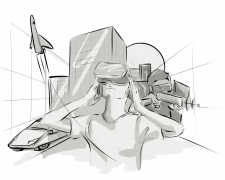The concept of the metaverse, a fully immersive virtual world, is becoming increasingly popular as technology continues to advance. To make this vision a reality, several key technologies will play a crucial role in its development and growth.
In this article, we discuss these technologies, including blockchain, cryptocurrency, augmented and virtual reality, artificial intelligence, and 3D reconstruction. By incorporating them into their games and virtual environments, developers can create a more engaging, personalized, and realistic experience for users while making it easier to manage and scale the virtual world.
Key Points
- The metaverse is a fully immersive virtual world that relies on several key technologies for its development and growth.
- Blockchain technology is a fundamental building block for most of the metaverse’s applications, providing decentralization, transparency, and immutability to transactions.
- Cryptocurrency is the only method of payment accepted in the metaverse, allowing users to purchase resources and assets.
- Augmented and virtual reality engines help facilitate the virtual world’s immersive and engaging three-dimensional environments, allowing users to experience physical simulations.
- Artificial intelligence plays a crucial role in the metaverse’s development and growth, helping create a more engaging, personalized, and realistic user experience.
- 3D reconstruction technologies are crucial in creating an environment that mimics the real world, making it possible to bring the metaverse to life.
What Technology Will Power the Gaming Metaverse?
While the metaverse is still far from being a reality, there are certain technologies that can establish the foundations, used to develop it further, and power the metaverse environment.
Blockchain
The metaverse relies heavily on blockchain technology as it serves as a fundamental building block for most of its applications. Blockchain technologies enable decentralization and transparency to ensure all the processes in the metaverse are operating seamlessly.
The main benefits of blockchain technologies are the fact that it provides greater transparency into transactions that are immutably recorded and time-stamped, which enables users to view the entire transaction history and minimizes the opportunity for fraud.
Developers utilize blockchain technology to incorporate various functionalities into the metaverse, including verifying digital ownership, transferring value, establishing governance, promoting digital collectability, facilitating accessibility, and promoting interoperability.
Using blockchain technology as a foundational element of the metaverse has several advantages:
- Keep track of transactions — blockchains act as a virtual ledger and create a record of all transactions issued in the metaverse. The data in a blockchain is stored in a decentralized database reducing the likelihood of malfunctions.
- Chains of data — blockchains are a method of storing information by grouping it into blocks. These blocks have a limited storage capacity and are closed once they’ve been fully filled. Once a block is complete, it is linked to the previous block to form a chain of data, which is known as the blockchain.
- Chronological order — blockchains arrange data chronologically and automatically based on their structure, create a timestamp of the record and make it impossible for the data to be changed or deleted. Once a block has been sealed, it is set in stone, allowing the entire process to be free from manipulation and providing transparency to all parties in the metaverse.
Cryptocurrency
Cryptocurrency is one of the main technologies used in the metaverse as this is the only method of payment accepted in the metaverse. There is no other way for users to carry out transactions in the metaverse other than exchanging real-world currencies (aka fiat currencies) for crypto.
They are used to purchase various resources in the metaverse, including NFTs, digital real estate, and in-game items. Cryptocurrency has become a valuable asset for only for the game players but also for investors who wish to make money off them in the future.
AR & VR
Augmented reality (AR) and virtual reality (VR) engines are essential components of the metaverse that help facilitate the immersive and engaging three-dimensional environments of the virtual world.
Virtual reality and the metaverse may appear to be similar, but they have some distinct differences. Virtual reality is only a part of the broader metaverse as it consists of several technologies that complement VR technology, such as augmented reality (AR), mixed reality (combines elements of VR and AR), blockchain technology, artificial intelligence (AI), and cloud computing.
VR technology can be compared to a puzzle, in the sense that it needs other complementary technologies to create a more immersive and interactive experience.
Virtual reality allows users to view and interact with 3D simulations, but it is unable to provide physical simulations, which is a crucial aspect of the metaverse.
This is where augmented reality helps as it expands the scope of the metaverse and enables users to actually experience physical simulations.
They can hear, feel, and interact with the virtual metaverse. The combination of VR and AR creates more realistic experiences that positively impact users but requires massive investments from tech companies.
Artificial Intelligence (AI)
Artificial intelligence has become an essential aspect of our daily lives by enhancing multiple processes of various devices to create a positive user experience.
For example, virtual assistants such as Siri, Alexa, or Google Assistant remind us about important tasks, send messages, make phone calls, and manage smart home devices such as thermostats, security cameras, and lighting systems.
AI is also used in navigation systems to calculate the best route to a destination based on real-time traffic and personal driving habits, as well as to support recommendation engines to suggest what type of content should be shown to a specific user.
Moreover, AI helps to identify fraudulent activities in banking systems and prevent fraud-like transactions from occurring.
Not to mention, self-driving cars and trucks that use AI to navigate roads, avoid obstacles, and make decisions based on real-time data from sensors and cameras.
AI is also being used in the development of the metaverse to:
- Plan business strategies.
- Speed up decision-making processes.
- Improve the user interface and experience.
- Help process data with machine-learning techniques.
- Create unique outputs and insights.
- Provide sensors for non-player characters.
- Translate content into multiple languages.
- Create metaverse avatars.
The use of AI in the metaverse can help create a more engaging, personalized, and realistic experience for users, while also making it easier to manage and scale the virtual world.
As the metaverse becomes more prominent in our lives, we can expect to see AI playing an increasingly important role in its development and growth.
3D Reconstruction
Although 3D reconstruction has been around for a few decades now, the recent COVID-19 pandemic has increased its usage since consumers were unable to visit stores during the lockdowns.
Therefore, many businesses are now utilizing 3D reconstruction technologies to create virtual tours of properties and showrooms. It was somewhat predictable that this technology would also spread into the metaverse.
Given that the metaverse is a 3D virtual world, it is understandable that 3D construction plays a crucial role in bringing the metaverse to life.
The challenge for the metaverse is to create an environment that mimics the real world by using special 3D cameras and other reconstruction technologies to render:
- Realistic 3D images
- Models of buildings
- Various everyday objects
The information gathered by 3D cameras and high-quality 4K photography is further processed by computers to produce realistic simulations that can be utilized in the metaverse.
The Internet of Things (IoT)
The idea of the Internet of Things (IoT) was initially introduced in 1999 and involves linking every physical component of our environment to the Internet using different sensors and devices.
In the case of the metaverse, IoT offers numerous benefits:
- IoT applications can gather data from the physical world and incorporate it into the metaverse to create more accurate and realistic virtual environments. For instance, weather or temperature data collected through IoT-enabled devices can help the metaverse adjust its environment accordingly.
- IoT can facilitate the seamless integration of the 3D world with a wide range of physical devices, resulting in real-time simulations within the metaverse.
- Through the use of AI and machine-learning algorithms, IoT can improve and optimize the metaverse environment by managing the data it collects.
Edge Computing & 5G
Edge computing is typically utilized in commercial settings to facilitate faster data transfer with minimal delays and ensure seamless experiences. It is one of the key factors that has made the metaverse viable as computers must handle the intense simulations efficiently to reduce lag and provide users with an immersive and uninterrupted gaming experience.
Another essential feature often coupled with edge computing is the availability of 5G networks.
Previously, users encountered network issues while participating in the metaverse due to slow rendering and data transfer speeds caused by the absence of high-speed Internet.
However, with the introduction of 5G and its availability at affordable rates, more users can enjoy the metaverse from their devices without any network-lag issues.
The combination of edge computing and 5G has allowed users to participate in the metaverse and enjoy a truly immersive experience.
Why Will NFTs Play a Major Role in the Gaming Metaverse?
Non-fungible tokens (NFTs), along with other digital assets, will play a crucial role in building the economy of the metaverse, as they serve as proof of ownership for virtual assets.
NFTs are exclusive assets that are stored on a blockchain, like Ethereum, Polygon or Solana. They serve as authentic documentation of ownership of virtual assets, which can only exist within the digital world.
The fact that they are stored on a public blockchain ensures their security and legitimacy, while making them easily transferable across different applications.
In 2022, the NFT market saw an organic trading volume of approximately $24.7 billion on various blockchain platforms and marketplaces.
It is predicted that revenue in the NFT industry will have reached $3.5 billion by 2023 and will continue to grow at a compounded annual rate (CAR) of 22.82% until 2027, resulting in a projected total revenue of $8.1 billion. The average revenue per user in the NFT sector is expected to be $70.46 in 2023.
The use of NFTs in gaming allows players to have complete ownership of their digital assets, such as skins, weapons, and handbags. This enables them to trade NFTs freely with other players in the same universe, sell them for real money, and potentially use them across multiple blockchains.
NFTs are often monetized through smart contracts, which execute specific actions when certain predetermined conditions are met.
For example, artists using NFT smart contracts can receive royalty payments on all subsequent resales of their pieces. Musicians can sell a stake in their songs to investors who will receive royalties every time the song is played on a streaming service.
NFTs also support the “play-to-earn” (P2E) gaming model, which provides gamers with a financial incentive to play games.
In P2E games, players earn cryptocurrencies that can be used within the game, sold on an open market, or monetized through smart contracts.
If a gamer creates an NFT character that someone else uses to earn cryptocurrencies, the creator receives a portion of those earnings. It contrasts with traditional gaming, where gamers acquire assets that have no real-world value.
NFTs are seen as a key element of the metaverse and can provide many benefits.
The use of NFTs in the metaverse can help:
- Increase customer satisfaction.
- Improve margins, enhancing product and service visibility.
- Foster collaboration with nontraditional gaming partners.
- Attract new customers.
Summary
The gaming metaverse relies on several technologies, including blockchain, cryptocurrency, AR/VR engines, AI, and 3D reconstruction. These technologies enable decentralization, digital ownership verification, immersive environments, an enhanced user experience, and realistic virtual worlds. Utilizing these metaverse technologies will play a crucial role in its continued development and growth.








